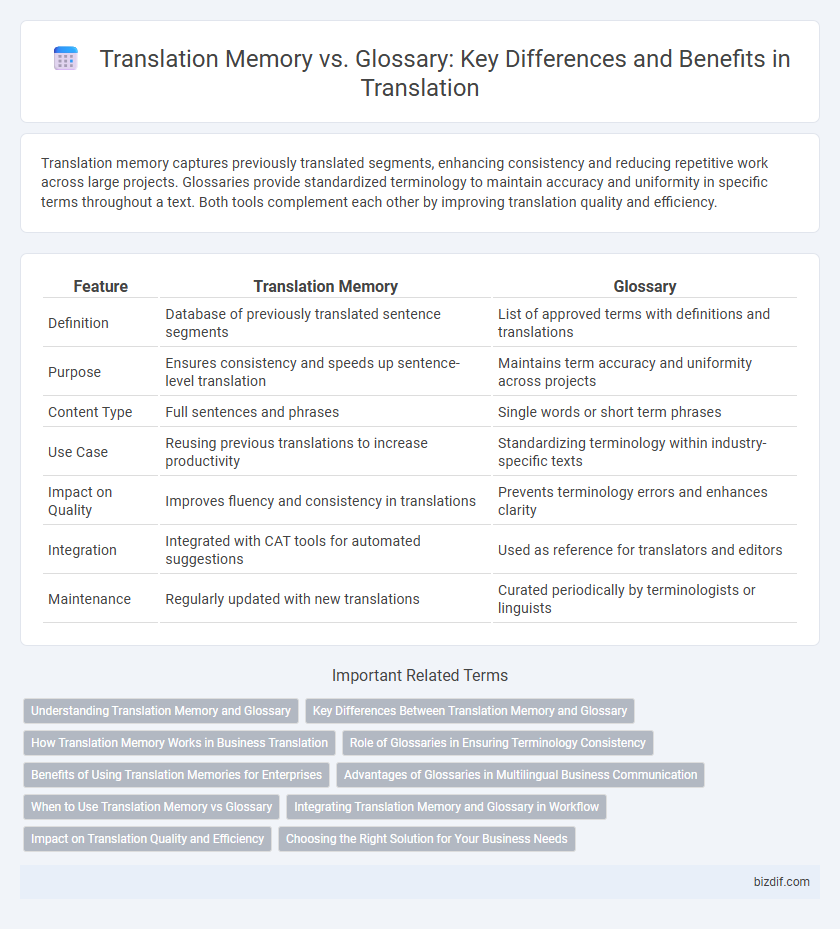Translation memory captures previously translated segments, enhancing consistency and reducing repetitive work across large projects. Glossaries provide standardized terminology to maintain accuracy and uniformity in specific terms throughout a text. Both tools complement each other by improving translation quality and efficiency.
Table of Comparison
| Feature | Translation Memory | Glossary |
|---|---|---|
| Definition | Database of previously translated sentence segments | List of approved terms with definitions and translations |
| Purpose | Ensures consistency and speeds up sentence-level translation | Maintains term accuracy and uniformity across projects |
| Content Type | Full sentences and phrases | Single words or short term phrases |
| Use Case | Reusing previous translations to increase productivity | Standardizing terminology within industry-specific texts |
| Impact on Quality | Improves fluency and consistency in translations | Prevents terminology errors and enhances clarity |
| Integration | Integrated with CAT tools for automated suggestions | Used as reference for translators and editors |
| Maintenance | Regularly updated with new translations | Curated periodically by terminologists or linguists |
Understanding Translation Memory and Glossary
Translation Memory stores previously translated segments, enabling consistent reuse of translations across projects while improving efficiency. Glossaries provide standardized terminology lists, ensuring accuracy and uniformity in specific domain vocabulary. Both tools complement each other by enhancing translation quality and consistency through different mechanisms: memory recall versus term standardization.
Key Differences Between Translation Memory and Glossary
Translation Memory stores previously translated segments to improve consistency and speed in future projects, while a Glossary contains approved terminology and specialized vocabulary to ensure accuracy and uniformity of terms. Translation Memory relies on sentence-level matching, enabling quick reuse of entire phrases, whereas a Glossary focuses on individual word or phrase definitions to guide translators' choices. Both tools enhance quality and efficiency but serve distinct functions in the translation process.
How Translation Memory Works in Business Translation
Translation Memory (TM) in business translation stores previously translated segments to improve consistency and speed in future projects, enabling translators to reuse content efficiently. By matching new text with stored segments, TM reduces repetitive work and ensures uniform terminology across documents. This technology significantly lowers costs and turnaround times while maintaining high-quality output tailored to industry-specific language.
Role of Glossaries in Ensuring Terminology Consistency
Glossaries play a critical role in ensuring terminology consistency by providing a curated list of approved terms and their definitions, which translators reference to maintain uniform language throughout a project. Unlike Translation Memory, which stores previously translated segments for reuse, glossaries focus specifically on standardizing key terms to prevent variation and confusion. This consistency enhances the overall quality and accuracy of translations, particularly in specialized fields such as legal, medical, and technical content.
Benefits of Using Translation Memories for Enterprises
Translation memories enhance consistency and reduce translation costs by storing previously translated text segments, enabling enterprises to reuse content efficiently across projects. They accelerate project turnaround times and ensure terminology accuracy, supporting global brand coherence. This technology integrates seamlessly with computer-assisted translation tools, increasing productivity and maintaining high-quality multilingual communication.
Advantages of Glossaries in Multilingual Business Communication
Glossaries enhance multilingual business communication by providing consistent terminology across all languages, ensuring brand voice and message clarity. They enable faster content updates and reduce translation errors by standardizing key terms and industry-specific jargon. Glossaries also improve collaboration among translators and stakeholders by serving as a centralized reference for accurate, contextually appropriate word use.
When to Use Translation Memory vs Glossary
Translation Memory (TM) is ideal for projects with repetitive content, enabling consistent reuse of previously translated segments to enhance efficiency and accuracy. Glossaries serve best when maintaining uniform terminology across specialized fields or brand-specific language is critical, ensuring precise and standardized word choice. Use TM to speed up translation workflows, while glossaries support consistent terminology management and quality control.
Integrating Translation Memory and Glossary in Workflow
Integrating Translation Memory and Glossary in a translation workflow enhances consistency and efficiency by leveraging past translations and standardized terminology. Translation Memory stores reusable segments, reducing repetitive work, while glossaries ensure accurate use of industry-specific terms and brand language. Seamless synchronization between the two tools enables translators to deliver precise, cohesive content across large projects and multiple languages.
Impact on Translation Quality and Efficiency
Translation Memory (TM) stores previously translated segments, boosting efficiency by reusing exact or similar phrases and ensuring consistency across large projects. Glossaries provide standardized terminology, enhancing translation quality by maintaining accuracy and brand-specific language throughout the text. Combining TM with glossaries optimizes both speed and linguistic precision, resulting in higher-quality translations delivered faster.
Choosing the Right Solution for Your Business Needs
Translation Memory stores previously translated segments, enabling faster and more consistent translations for repetitive content, making it ideal for large projects with frequent updates. A Glossary provides standardized terminology, ensuring brand consistency and accuracy in specialized vocabulary across all texts. Selecting the right solution depends on whether your priority is efficiency in translating bulk content or maintaining precise, uniform terminology.
Translation Memory vs Glossary Infographic

 bizdif.com
bizdif.com